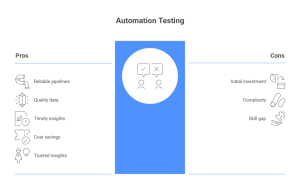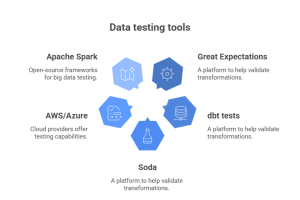Introduction to Automation Testing in Data Platforms
Data platforms have become the backbone of decision-making for most enterprises. But as data volumes grow and pipelines become more complex, manual testing can’t keep up. Automation testing is now critical to ensure that data pipelines run reliably, data quality remains uncompromised, and insights are delivered on time.
For IT leaders in industries like finance, healthcare, and retail, automation testing is not just a cost-saving measure—it’s the difference between trusted insights and flawed reporting.
Why Automation Testing Matters for Modern Data Engineering
Ensuring Data Accuracy and Reliability
Inaccurate data leads to wrong decisions. Automation testing establishes consistent data quality assurance by validating datasets at every stage—ingestion, transformation, and storage. It helps businesses like yours identify broken data pipelines before they impact dashboards, customer reports, or predictive models.
Reducing Time-to-Insight with Faster Pipelines
Enterprises no longer want to wait days for reports. Automated data pipeline testing reduces manual intervention, allowing teams to move from raw data to actionable insights faster. In 2025, many organizations report that automation cut testing cycles by more than 40%, accelerating time-to-insight significantly.
Common Challenges in Automation Testing for Data Platforms
Handling Large-Scale Data Volumes
Big data testing is never simple. Terabytes of data flowing through multiple systems create challenges in test coverage and validation speed. Sampling can miss anomalies, while full-volume testing can overwhelm infrastructure if not designed carefully.
Schema Evolution and Data Drift Issues
Data platforms are dynamic—schemas evolve, sources change, and business rules get updated. Without robust automation, schema drift often causes broken pipelines, incorrect mappings, or loss of critical fields. This makes schema-aware testing a necessity, not an option.
Best Practices for Effective Automation Testing in Data Platforms
Implementing Reusable Test Frameworks
Reusable frameworks save time and reduce duplication. Creating modular test cases for ingestion checks, transformation logic, and aggregation validation ensures consistency across different pipelines.
Leveraging Cloud and CI/CD for Data Testing
Cloud-native platforms make scaling test environments easier and more affordable. Combined with CI/CD, businesses can run automated tests every time a data pipeline changes, reducing risks of faulty deployments. Many IT leaders in the USA and UAE are already embedding pipeline validation into their DevOps practices.
Monitoring & Continuous Validation
Testing doesn’t stop at deployment. Continuous monitoring ensures that real-time data streams remain accurate, and anomalies are flagged instantly. Monitoring also provides early alerts for data drift, allowing corrective actions before it impacts reporting or analytics.
Tools & Technologies for Automation Testing in Data Engineering
The market for data testing tools has grown rapidly. Platforms like Great Expectations, dbt tests, and Soda help validate transformations. Cloud providers such as AWS and Azure offer built-in testing capabilities for pipelines. For large-scale big data testing, open-source frameworks like Apache Spark-based validation frameworks are often preferred.
At Techmango, we often combine off-the-shelf tools with custom-built frameworks, ensuring our clients’ needs—whether data pipeline testing, governance, or compliance—are fully met.
Future of Automation Testing in Data Platforms
By 2027, industry analysts predict that more than 70% of enterprise data platforms will use AI-assisted test automation. Machine learning models will detect anomalies, predict schema changes, and recommend test scenarios automatically.
For businesses like yours, this means automation testing will not just validate data—it will actively enhance resilience, compliance, and agility in data engineering services.
Conclusion
Automation testing is now an essential pillar of modern data engineering. From handling massive data volumes to ensuring data quality assurance, it provides the reliability businesses need to make fast, confident decisions. While challenges exist, best practices and the right tools make automation both achievable and scalable.
At Techmango Technology Services, we help enterprises design and implement automation strategies that secure their pipelines, improve data accuracy, and reduce operational risks.

